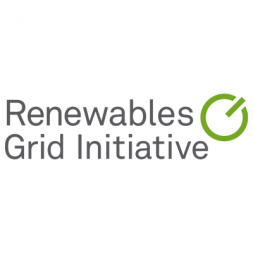
Energy Systems
January 2023 - October 2024
To make power system resilient to meteorological events happening on short time scales and climate change, this use case intends to improve energy system modelling for grid planning and resources adequacy assessment.
This use case ran from January 2023 – October 2024 and is now closed.
Challenge
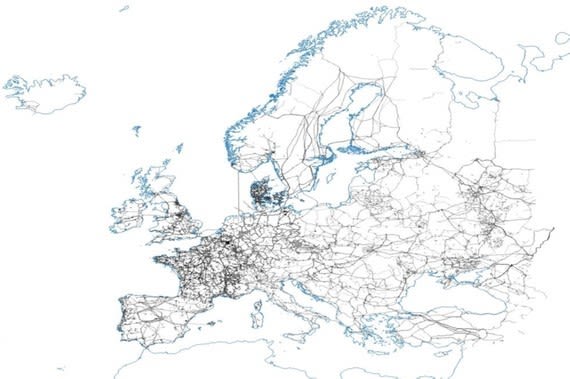
As a response to climate change, countries around the world have set ambitious targets for integrating renewable resources into existing electricity systems. Reacting to the Russian invasion in Ukraine and the energy crisis in Europe, the EU recently has put into force RePowerEU, an ambitious initiative with the aim to make Europe independent from fossil fuels “well before 2030” by increasing the renewables target for 2030 from 40% to 45% (amongst other measures like increases in efficiency, decarbonizing industry, and a diversification of the energy supply). The latter includes 320 GW additional PV capacity to be deployed by 2025 and almost 600 GW by 2030.
This initiative has direct and indirect effects on the responsibilities of the grid planning and operation authorities in Europe. They are experiencing a rapid process of changing duties and giving up habits. The rising share of the variable renewables resources in the electricity supply system increase the system’s exposure to meteorological variability. On the one hand, this variability makes the operation of the system more complicated and defines new (additional) constraints on the design of the power system. On the other hand, it causes the necessity to include information about climate change in decision-making processes of the energy sector. Assets for the generation, transmission or storage of electricity usually have lifetimes between twenty and fifty years. During this period of time, meteorological conditions might change significantly, depending on how climate change evolves.
Use Case Overview
To ensure the security of supply, meaning the access to electricity for everyone, everywhere and at any time, the power system must be resilient to both, meteorological events happening on short time scales and climate change. As a response to that, many directives, which define rules, methodologies and responsibilities for/of grid planning and operation authorities, are currently being revised and updated. Databases widely used in the energy sector are currently being extended to include prospective meteorological information and information about the uncertainty of climate change. To cope with these changes, many stakeholders have been increasing their research and development activities and seek for collaboration and exchange between different players but also across the energy and climate disciplines.
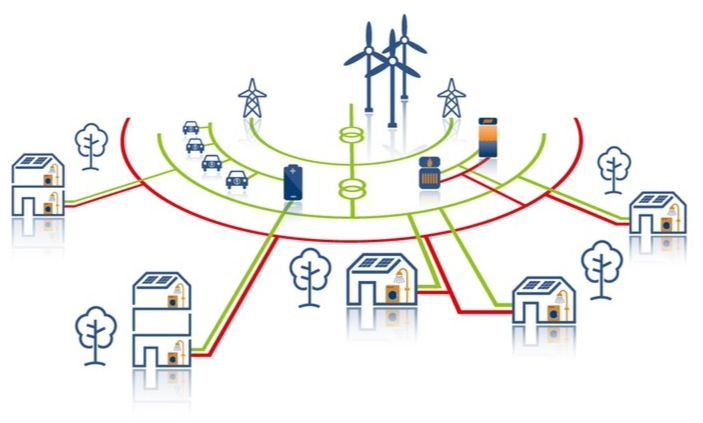
Fostering this collaboration and exchange was one of the aims of DestinE’s Use Case Energy Systems. Building upon a thorough user engagement strategy, this use case aimed at providing tools and guidance to support the European Transmission and Distribution System Operators to fulfil their policy-mandates and to make a valuable, pro-active contribution to achieving the policy objectives defined by the EU parliament and the member states, using DestinE.
DestinE is expected to make a great contribution to improved energy system modelling for grid planning and resources adequacy assessment by mainly two means:
1. A more accurate and realistic representation of the variability of the renewable resources and, hence, their potential to contribute to the future power supply in a European energy system.
2. A more seamless integration of the climate and the energy model, avoiding intermediate steps and allowing for the representation of feedback loops.

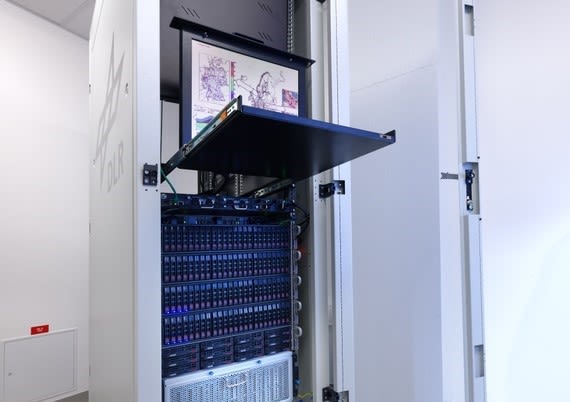
One major concern about renewables is the occurrence of ramping events, the rapid and strong de- or increase in power generation from wind turbines and/or solar PV. These events put severe stress on the electricity grids. The proper handling of them has a high economic value for electricity suppliers and grid operators. Ramping events in PV and wind power are related to fast changes between cloudy and sunny conditions, and passing storm fronts, respectively.
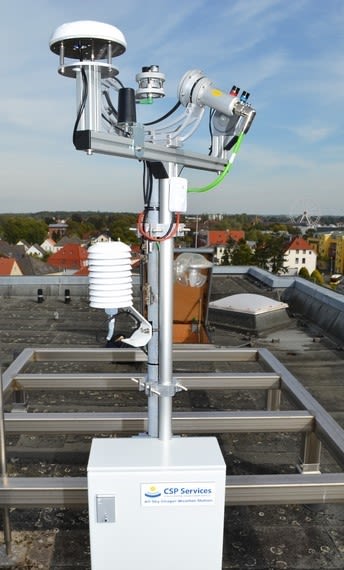
Hence, DestinE’s capability to resolve clouds and storms with an hourly temporal resolution can be expected to lead to a more realistic representation of them in the data used for power system applications and, consequently, increase reliability and trustworthiness of the data. Indeed, DestinE might become a major source for the meteorological input in energy system models applied in the user community in the future.
To support this, DLR and its partners have used DLR’s energy system modelling capabilities to implement a representative demonstrator exemplarily showcasing the use of climate scenarios in grid planning and resources adequacy assessment applications. This implementation was complemented by the development of a set of user-friendly tools and methods to ease the integration of climate information and to support the users to make appropriate data choices.
The performance and the impact of these implementations and the new DestinE data was assessed by an observation-based data validation, a thorough sensitivity and uncertainty analysis and a user survey. Overall, DestinE’s Use Case Energy Systems has investigated what a difference DestinE makes for energy systems modelling.
Starting phase (January to July 2023)
Based on a user consultation process started during a User Needs Workshop organized by the Renewables Grid Initiative, the technical design of the use case has been specified further. Several European transmission and distribution system operators expressed their expectations on DestinE and helped defining the targeted functionalities of the use case’s demonstrator. Concretely, the need for having access to validated data and for techniques to reduce the simulation efforts have been emphasized. To address this, tools are developed to select representative weather or climate periods from climate projections with uncertainty information and to assess the sensitivity of the European Adequacy Assessment (ERAA) on the meteorological input.
As a first step towards the implementation of our demonstrator, the Pan-European Climatic Data Base (PECD) and the Pan-European Market Modeling Data Base (PEEMDB) – the two data bases used by the European transmission system operators for their annual adequacy assessment – have been acquired and processed. This data is used for the energy system simulations and serve as a reference for all the following investigations. In particular, the data set includes information about the installed capacities for the generation, transmission and storing of electricity (Figure 2), and the time series for the demand for electricity in the European bidding zones (Figure 1) as well as the generation from the variable renewables resources wind (Figure 3), solar photovoltaics (Figure 4) and hydro (Figure 5).
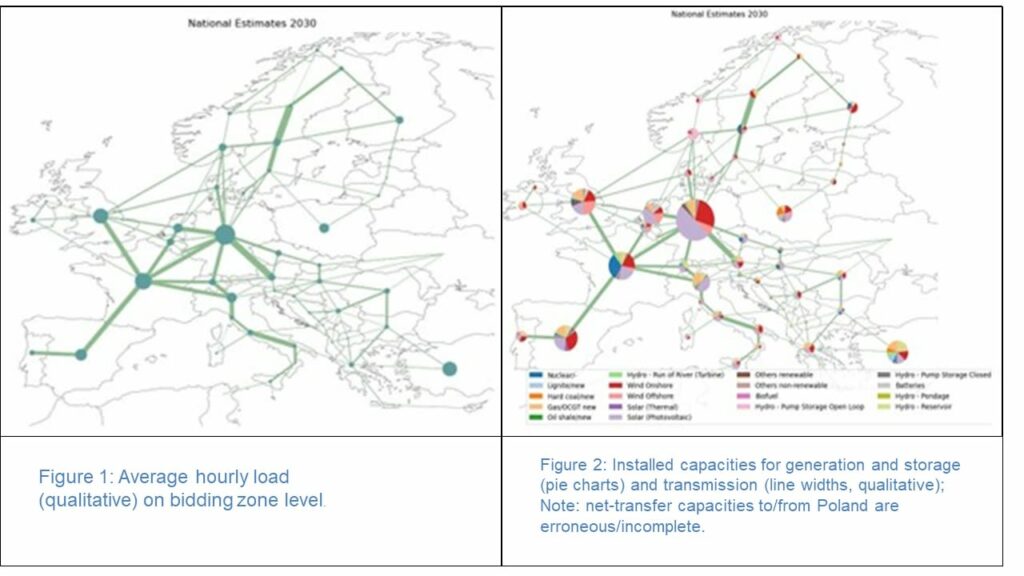



August to September 2023
As a next step DLR implemented the Pilot. This Pilot is an open-source implementation of ENTSO-E’S ERAA with the open energy system model REMix. Core element of the Pilot is a snakemake workflow, which downloads, extracts and pre-processes the relevant data sets, and simulates the European power system for a set of scenarios and weather years to assess the adequacy of the resources for meeting the projected demand. Additionally, the original capacity factors for wind and solar power obtained from the PECD can be replaced by two additional datasets: (i) the “ERA5 derived time series of European aggregated surface weather variables, wind power, and solar power capacity factors” from Bloomfield et al. [2021]2 published by the University of Reading (in the following referred to as “Reading” data set), and (ii) renewables.ninja3.
This allows to investigate the sensitivity of the power system simulations on the meteorological input. In the further course of the use case, this capability will be used to quantify how ERAA can benefit from the new DestinE data. All code will be made available from the Destination Earth github repository.
First simulations with the three different data sets lead to some remarkable differences in the adequacy of the resources as measured via the Loss of Load Expectation (LOLE). In Germany, for instance, the number of hours per year, during which the power system is unable to meet the local demands for electricity increases from 65 hours per year obtained from the simulations using the PECD to 117 hours per year using the Reading data set and to 221 hours per year using the renewables.ninja data set, respectively. Similar differences were found in UK, Ireland, and in the Northern and Baltic States. During the next months, the differences between the data sets and their impact on resources adequacy were investigated in more detail.
The last three months of the year were used for automatising our workflow further and for validating our model. This considered the most recent version of the PECD used for ERAA 2023 plus some additional scenarios for wind power capacity factors obtained from the Danish Technical University4 and run simulations for all weather years available in the data sets (Figure 7) – well-structured and user-friendly in a snakemake workflow, prepared to use the first simulations of the Climate DT. To validate our model, we performed a benchmarking with the adequacy assessment model of one of the four German transmission system operators.
Furthermore, we again made some efforts to engage with our core user community. As a first step of the Performance and Impact Assessment of our use case, we prepared a user perspective Survey and a User Perspective Workshop in early February 2024.
The use case also contributed to the Visualisation & Immersive Technologies activities. In this context, ideas were formulated for how machine learning techniques can be applied to derive first-guess power system simulations on-the-fly in the visualization tool.
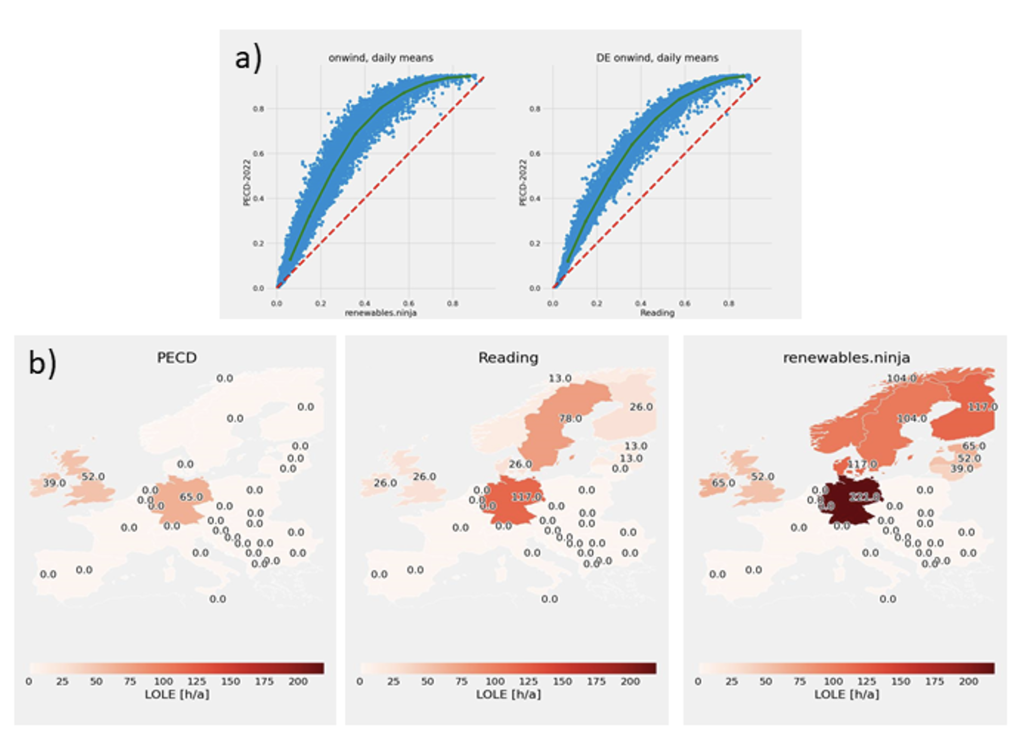
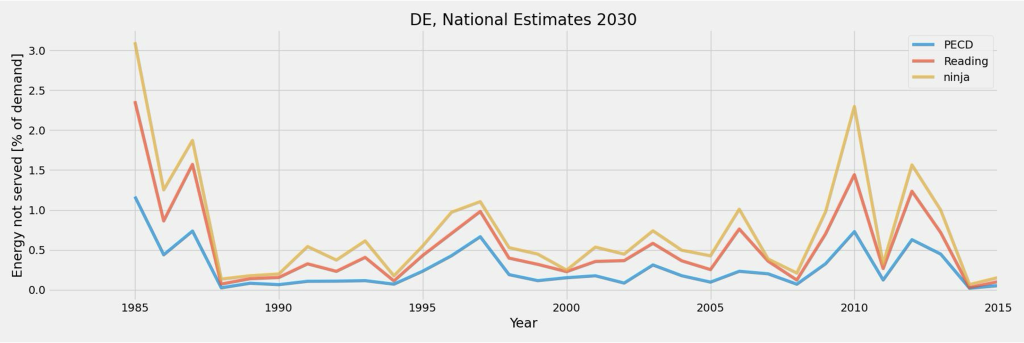
January to July 2024
Early 2024, we accomplished two further milestones of our use case: A User Perspectives online survey and a User Perspective workshop to collect feedback on the use case developments from energy system modelling experts.
The User Perspectives online survey was disseminated over a period of 6 weeks, in early 2024. A broad range of experts, including representatives from transmission system operators, consultancies, agencies and research centres, participated. A broad dissemination of the survey enabled to enrich the community of interested stakeholders, as most of the respondents were new to the DestinE Initiative (section 3.2.1).
The User Perspectives workshop was attended by a group of 30 experts from 18 organisations in the field of climate and energy system modelling. The participatory design of the User Perspectives Workshop allowed for important discussions between users and DestinE network. The stakeholders provided relevant feedback on how to further shape user-friendly tools and approaches. Participants also expressed the benefit of DestinE to their work, which offers both a platform of collaboration as well as technical support to understand, and account for, the impact of climate change on their specific applications.
For detailed results of the survey and the workshop please see the User Perspective Report here:
During the second quarter 2024 we accomplished several important milestones. After getting access to the first data of the Climate DT we set up the workflow to download data from the historical experiments of the IFS-Nemo and ICON models and to convert weather information to the time series we need to run our energy system simulations. Additionally, we started to validate the Twin’s data with meteorological measurements of clouds and radiation. In Figure 8 the solar radiation at the surface obtained from the twins is plotted together with measurements for the city of Oldenburg in Germany. Note that historical data from climate simulations cannot be compared with measurements on a time step by time steps basis. This figure is to illustrate the general behaviour of the data only.
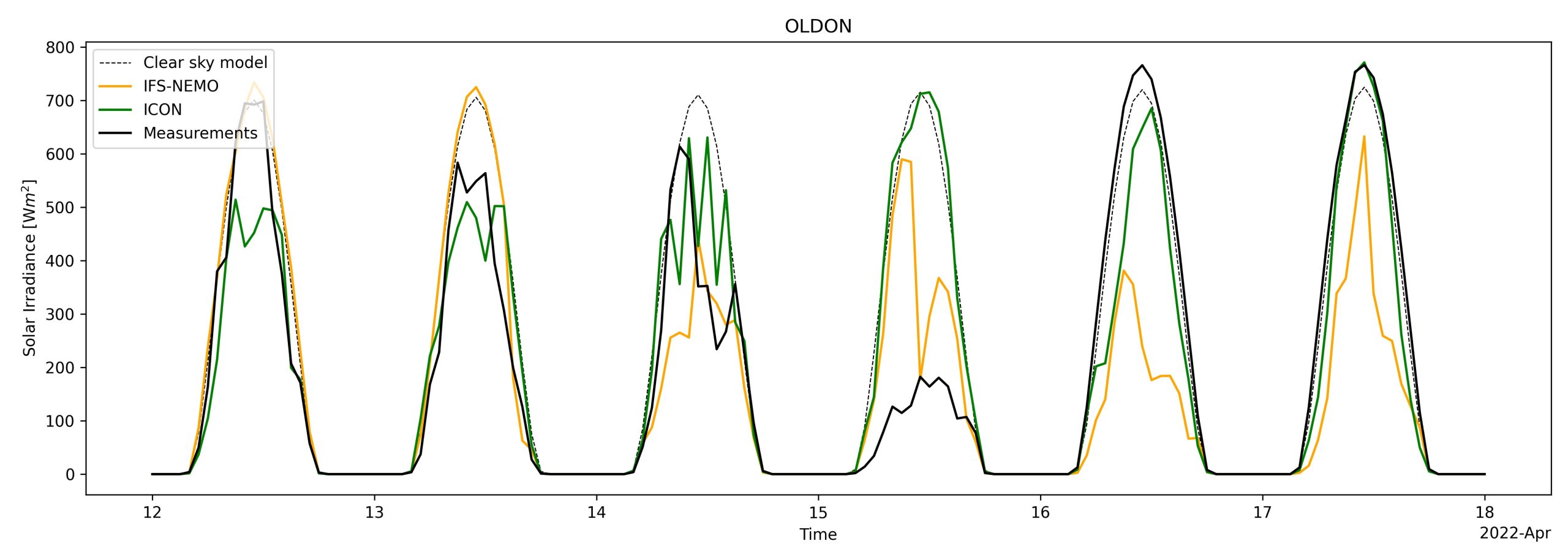
As a second milestone we completed the development of a set of user-oriented tools. This includes a workflow for a standardized assessment of the energy systems simulations conducted with our demonstrator on the meteorological input and a proof-of-concept for applying machine learning to speed up the simulations. For the latter, we applied the approach using attention neural networks developed by Chen Li et al.5 to our demonstrator.
Wrap-up (August to October 2024)
The last phase of this use case was dedicated to the performance and impact assessment of our demonstrator. We systematically assessed the performance of DestinE’s Energy Systems demonstrator and the potential impact of DestinE for grid planning and adequacy assessment applications. From this assessment, recommendations were formulated for the further development of DestinE’s activities for the energy sector and of the DestinE components, in particular the Climate DT and the quality and uncertainty quantification. For this, we also included the user feedback collected during a concluding webinar which we organised. The perspectives shared by representatives of the policymaking and industry emphasised the relevance of the use case, its findings and accompanying activities. The full recording of the webinar can be found here.
Overall, we found that DestinE has the potential to make great contributions to an improved energy systems modelling. To foster the uptake of the DestinE data and DestinE’s machine learning capabilities, further demonstrators and use cases have been found crucial. The same holds for the quality control and uncertainty quantification mechanisms. Here, the inclusion of dedicated energy-related metrics for assessing the quality of the climate simulations from an energy systems perspective into AQUA appears reasonable. Similarly, the uncertainty assessment should be extended, ideally through successively adding new climate models — similar to the approach applied for the most recent version of the PECD (version 4) — during the further course of DestinE.
In summary, DestinE’s Energy Systems Use Case achieved all its major goals. It demonstrated the capabilities of DestinE for the energy sector and opened the door for several future improvements and new developments in upcoming phases of the initiative, including a deepened exchange with the energy sector and other relevant European activities.
Video presentation
Watch the video below to learn more about the energy systems use case.
[1] Capacity factors give the unitless ratio of the actual maximum energy generation of a power unit over the theoretical maximum energy generation for a given point in time. For the volatile renewable resources wind and solar, the capacity factor is determined by the prevailing meteorological conditions (wind speed, solar irradiance, temperature). The capacity factor is a main model parameter for power system simulations.
[2] https://doi.org/10.17864/1947.000321
[3] https://doi.org/10.11583/DTU.c.5939581.v3
[4] https://doi.org/10.1016/j.apenergy.2024.122779
[5] https://doi.org/10.11583/DTU.c.5939581.v3



